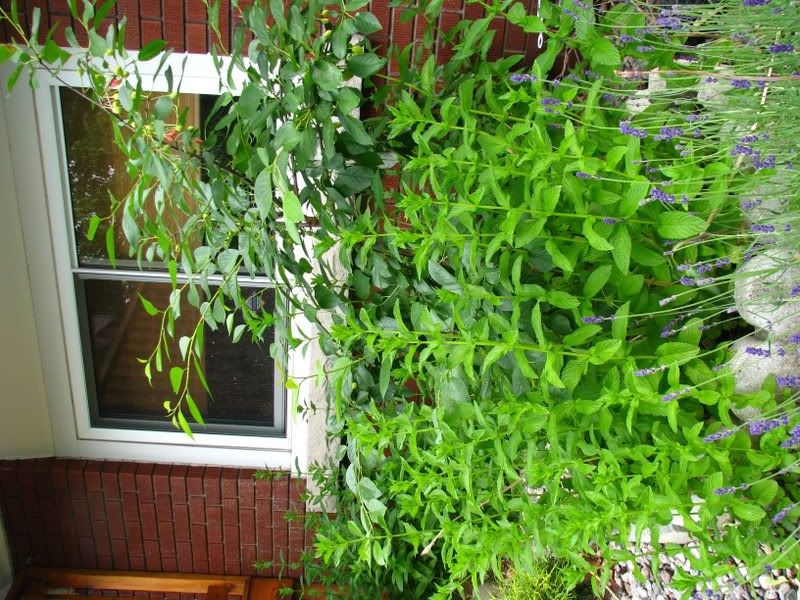
Tuesday, January 27, 2009
A bit of green against the whiteout
A superfulous picture with colour in it from the summer. It is of my young Evans cherry bush / tree being a bit overrun by grandpa's mint. That's Munstead lavender in the foreground. If you look really closely, you'll see the cherries developing but don't blink or my kids will eat them before you can glimpse them again.


Fruiting and nutting trees for Ottawa
So what if nutting is not a word, I'm using it anyhow. And yes this article is way later than I intended. My excuse is that there was a minor event outside of the internet world that I had to attend to. Now I wired back in so hopefully all future articles will be on time ;-)
Here is a list of plants that bear edible fruit and nuts for the Ottawa area:
Short plants
Cranberry - A native north American species that needs a moist, acidic soil rich in organic matter for best production. Vaccinium macrocarpon is the large fruited variety grown commercially and Vaccinium oxycoccus is a dwarf variety sometimes called moss cranberry.
Bunchberry (Cornus canadensis) - Another north american. This creeping dogwood likes to live in the understory of a deciduous forest with lots of cool, humusy leaf litter. Generally, I've heard that the taste is 'okay.'
Mayapple (Podophyllum peltatum) - The fruit of this understory plant is also edible but as it has so many warnings attached to it, I'd prefer just to grow it for its attractive appearance and the fact that it is a native rather than as food. But if the fruit is RIPE you can eat it according to most sources. Like I said, doesn't make you run out and grab a handful.
Wintergreen (Gaultheria procumbens) - Back in safe territory, I was charmed by the description in Farmer Boy by Laura Ingles Wilder about her husband to be digging the berries out of the snow for a frozen treat in wintertime. You will not be surprised to learn that it has a strong 'wintergreen' flavour. It is a common understory plant in acidic soils and though prefers moist (not soggy) soil, it will grow in dryer conditions. From what I've read, it doesn't like clay.
Ligonberry (Vaccinium vitis-idaea ssp. minus) - Looking very much like the cranberries that it is related to, this is a low growing alpine plant that occurs in northern understories. More than that, I do not know. There are some developed cultivars.
Perennial ground cherries (clammy and smooth) - There are various members of the Physalis genus that are perennial and produce tasty husk tomatoes that can be eaten fresh or cooked. The fruit must be ripe before eating. It will often fall from the plant when ripe and can be gathered up then. The fruit will last awhile in their protective husks. I have not got my hands on either of the above species mentioned but I hope to one day. In the meantime, I grow Physalis pruinosa, an annual that self seeds in some gardens.
Strawberries - The delights of strawberries can not be overestimated. There are many varieties from the tiny wild ones to alpines that hang from little stems on neat plants which make great edging for a sunny border to the classic heavy June bearers that fill your basket with delicious red jewles. Alpine strawberries do not have runners but form neat little mounds that produce a steady though small harvest of sweet berries all year.
Rhubarb - Not really a fruit but used in dessert recipes. What can I say? It will grow in part shade to sun, likes a rich soil and will produce for years.
Bush fruit
Serviceberry etc... (Amelanchier ssp.) - A number of thicket and bush berries fall under this Genus and would be suitable for growing in Ottawa. They like full sun and are apparently delicious. The Ottawa Tree Program usually has them available in their smaller / medium sized tree catagory. I would grow some but I can't figure out where I would squeeze one into the garden.
Sour bush cherries (Prunus) - Several forms of bush cherry with sweet / sour fruit make nice crops here some are sweet enough to eat out of hand especially when ripe. I grow Evans cherry and rarely get to taste it because the kids gobble it up before I can. Nanking Cherry has a good reputation as well. A friend of mine grew it as an edible and productive hedge on his urban property. Both are self fertile.
High bush cranberry (Viburnum trilobum) - A very attractive bush that yields berries suitable for making a jam that has an interesting aroma much like stinky cheese. They are considered a substitute for cranberries and are better after a frost.
Blueberries (Vaccinium ssp.) - Lots of breeding has gone into this plant so you have low, high, medium and rabbiteye types. The taller rabbiteye varieties grow in low chilling zones down south. The low bush types grow wild around here and have a fantastic taste. They prefer sun but will do well on a sunny edge or in part shade which is where they are often found in their natural habitat. These are the classic acidic plants and they cannot withstand moisture stress. If you provide them with the right conditions, they will reward you with wonderful fruit and a lovely fall display of bright red leaves.
Currants / Gooseberries / Jostaberries (Ribes ssp.) - I grow red currants but golden, white and black currants are also available. My kids love gobbling up the tart but tasty berries and this is another plant that I have yet to have enough to make jam with because it is all eaten fresh. Gooseberries are generally much larger than Currants and Jostaberries are a cross between the two. All will grow in partial shade.
Rugosa rose hips (Rugosa: various) - Some roses have nice edible hips. I'm not a huge fan but lots of people love them and they are produced on a pretty and very hardy plant.
Elderberry (Sambus: various) - An attractive shrub with edible flowers and berries - only the ripe berries. Everything else about the plant could make you ill. I have never tried the oft mentioned flower fritters as I can't figure out how you would eat only the flowers and not any teeny bit of stem but maybe I just need to see it done. Grows wild around here but make sure you positively identify them before sinking your teeth in.
Mulberry (Morus: various)- These would be considered borderline hardy and if it wasn't for the masses of mulberry bushes I see everywhere, I wouldn't recomend growing them. If you have a sheltered sunny location though they can produce a great crop.
Tree fruit
Small plums - Many species of plums will grow around here but I particularly like the Montreal Plum which is self fertile and produces a bountiful crop in good years (last year was not a good year for us for some reason). There are also several forms of small plum like the Manchurian Plum and wild plums. The size of these bush / trees will vary on their growing conditions. In the crowded conditions of the wild, they are generally bushy. I have just seeded some Manchurian Plum in the fall so I'll let you know how it does over the years.
Sour Cherry (Prunus cerasus) - If you are looking for a large sweet cherry to grow here, I'm afraid you are out of luck but many types of sour cherries will do well and they make superior cooked desserts anyhow. I have seen Montmorency cherries growing here and other cultivars that might be okay are Meteor, and Northstar. Some would be considered borderline here.
Apples (Malus ssp.) - From wild apples, crabapples to large eating apples, there are lots of varieties to choose from that will do quite well in Ottawa. Look for disease resistant cultivars to reduce or eliminate spraying. If you can live with a few defects, you may not need to spray at all. Many larger crab apples also make great preserves.
Pears (Pyrus communis)- Many of my neighbours grow pears and they are delicious but several pear growers I know have trees that suffer from fire blight - a slow death for the tree and a source of contagion for others trees. Generally more than one pear variety will need to be planted for fertilization. There are several fire blight resistant varieties like Moonglow and Seckel - both are borderline hardy from what I can tell.
Peaches / apricots - Though there are some trees that are hardy here their blossoms can be killed by frosts lowering or eliminating the harvest. The peach cultivar 'Reliance' is reliable for some people.
Hawthorn (Crataegus ssp.) - often ornamental with varying degrees of edibility. They resemble little apples.
Mountain Ash (Sorbus ssp.) - My kids enjoy eating these berries even though they are supposed to be inedible before a frost. Go figure. I think the fruit look like tiny pumpkins. They are a common ornamental around here but go easy on them as there are some reports of toxicity.
Sea buckthorn (Hippophae L) - These sour berries have to be carefully harvested off a thorny, tall upright bush / tree that is occasionally used as a windbreak. It is considered very nutritious and though mostly I have read that you have to eat it with liberal additions of sugar, some people have eaten it out of hand.
Various bird cherries - Normally collected wild and made into jam. They are pretty bush / trees but often have a suckering habit that can become invasive.
Vining fruit
Hardy kiwi (Actinidia arguta and Actinidia kolomikta) - Okay, so these grape sized kiwis are supposed to be hardy around here but I understand that they have a long growing season so can't really be relied upon for a harvest. Alongside the peaches, I would see this as a bonus crop if you were lucky that year. Both a male and a female plant are needed to produce fruit and the Male of A. Kolomikta has beautiful white and pink splashed foliage, is slightly hardier and produces smaller fruit than the A. arguta.
Grapes (Vitis)- There are lots of hardy grapes, some wild and some are cultivars such as the infamous concord. The taste of the fruit varies according to the type but the leaves of most types can be delicious when used young are as wraps.
Raspberries (Rubes) - Anyone walking the woods will know that various kinds of raspberries grow here. Plant them where you want them to stay because suckering is a their speciality but the rewards are sweet. Also tayberry though I've never tried them.
Nuts
Hazlenuts / Filberts (Corylus) Common commercial hazelnuts would not do well here but there are several wild types such as beaked hazelnut (Corylus cornuta) that you could try to wrestle from the squirrels. It is one of the recommended species for building a wildlife hedgerow in part shade (other plants people can also eat on this page too). Also hope springs eternal that crosses of Turkish filbert will develop cultivars that are hardy in our zone. Did I mention that I love hazelnuts?
Beech (Fagus) - These are also edible though small and fiddly.
Black Walnut (Juglans nigra) - This tree is infamous for creating an unfriendly environment by exuding juglone from its roots which causes poor growth of most plants beneath it. This plant would probably be considered borderline hardy here in that it is listed as zone 5.
Butternut (Juglans cinerea) - Related to walnut, they produce juglone. If you can get beyond and its slow growth then it can make a high calorie, nutritious food source. I am not sure of its hardiness but I have seen trees growing around here.
Shagbark Hickory (Carya ovata) - This tree has also been accused of producing juglone though in minimal amounts. It has attractive bark that lays against the trunk in shaggy ribbons and produces nuts that are described as pleasant tasting.
Gingko - I guess the nuts of this fruit are edible, even a delicacy, but the fruit smells so bad that nurseries generally only sell the male plants. They are pretty with their prehistoric trees that turn golden in the fall.
White Oaks (Quercus ssp) As far as I know, all oaks have edible nuts once tannins are leached out. They are very hardy and though red oaks seem to dominate the urban landscape of Ottawa, white and bur oaks also grow here. The white oaks have less bitter nuts so are more desirable as food but all oaks contain high amounts of tannins as I understand it. Apparently, the kind of tannin in white oaks is just harder to taste - I'll try and dig up the reference. You can leach the tannins to produce a nutritious and tasty flour.
---
Enjoy. As always corrections and additions are appreciated as are stories of growing any of the above species. Did it work for you?
Links:
Nut Growers of Ontario
Old list of fruit trees for Ottawa
Here is a list of plants that bear edible fruit and nuts for the Ottawa area:
Short plants
Cranberry - A native north American species that needs a moist, acidic soil rich in organic matter for best production. Vaccinium macrocarpon is the large fruited variety grown commercially and Vaccinium oxycoccus is a dwarf variety sometimes called moss cranberry.
Bunchberry (Cornus canadensis) - Another north american. This creeping dogwood likes to live in the understory of a deciduous forest with lots of cool, humusy leaf litter. Generally, I've heard that the taste is 'okay.'
Mayapple (Podophyllum peltatum) - The fruit of this understory plant is also edible but as it has so many warnings attached to it, I'd prefer just to grow it for its attractive appearance and the fact that it is a native rather than as food. But if the fruit is RIPE you can eat it according to most sources. Like I said, doesn't make you run out and grab a handful.
Wintergreen (Gaultheria procumbens) - Back in safe territory, I was charmed by the description in Farmer Boy by Laura Ingles Wilder about her husband to be digging the berries out of the snow for a frozen treat in wintertime. You will not be surprised to learn that it has a strong 'wintergreen' flavour. It is a common understory plant in acidic soils and though prefers moist (not soggy) soil, it will grow in dryer conditions. From what I've read, it doesn't like clay.
Ligonberry (Vaccinium vitis-idaea ssp. minus) - Looking very much like the cranberries that it is related to, this is a low growing alpine plant that occurs in northern understories. More than that, I do not know. There are some developed cultivars.
Perennial ground cherries (clammy and smooth) - There are various members of the Physalis genus that are perennial and produce tasty husk tomatoes that can be eaten fresh or cooked. The fruit must be ripe before eating. It will often fall from the plant when ripe and can be gathered up then. The fruit will last awhile in their protective husks. I have not got my hands on either of the above species mentioned but I hope to one day. In the meantime, I grow Physalis pruinosa, an annual that self seeds in some gardens.
Strawberries - The delights of strawberries can not be overestimated. There are many varieties from the tiny wild ones to alpines that hang from little stems on neat plants which make great edging for a sunny border to the classic heavy June bearers that fill your basket with delicious red jewles. Alpine strawberries do not have runners but form neat little mounds that produce a steady though small harvest of sweet berries all year.
Rhubarb - Not really a fruit but used in dessert recipes. What can I say? It will grow in part shade to sun, likes a rich soil and will produce for years.
Bush fruit
Serviceberry etc... (Amelanchier ssp.) - A number of thicket and bush berries fall under this Genus and would be suitable for growing in Ottawa. They like full sun and are apparently delicious. The Ottawa Tree Program usually has them available in their smaller / medium sized tree catagory. I would grow some but I can't figure out where I would squeeze one into the garden.
Sour bush cherries (Prunus) - Several forms of bush cherry with sweet / sour fruit make nice crops here some are sweet enough to eat out of hand especially when ripe. I grow Evans cherry and rarely get to taste it because the kids gobble it up before I can. Nanking Cherry has a good reputation as well. A friend of mine grew it as an edible and productive hedge on his urban property. Both are self fertile.
High bush cranberry (Viburnum trilobum) - A very attractive bush that yields berries suitable for making a jam that has an interesting aroma much like stinky cheese. They are considered a substitute for cranberries and are better after a frost.
Blueberries (Vaccinium ssp.) - Lots of breeding has gone into this plant so you have low, high, medium and rabbiteye types. The taller rabbiteye varieties grow in low chilling zones down south. The low bush types grow wild around here and have a fantastic taste. They prefer sun but will do well on a sunny edge or in part shade which is where they are often found in their natural habitat. These are the classic acidic plants and they cannot withstand moisture stress. If you provide them with the right conditions, they will reward you with wonderful fruit and a lovely fall display of bright red leaves.
Currants / Gooseberries / Jostaberries (Ribes ssp.) - I grow red currants but golden, white and black currants are also available. My kids love gobbling up the tart but tasty berries and this is another plant that I have yet to have enough to make jam with because it is all eaten fresh. Gooseberries are generally much larger than Currants and Jostaberries are a cross between the two. All will grow in partial shade.
Rugosa rose hips (Rugosa: various) - Some roses have nice edible hips. I'm not a huge fan but lots of people love them and they are produced on a pretty and very hardy plant.
Elderberry (Sambus: various) - An attractive shrub with edible flowers and berries - only the ripe berries. Everything else about the plant could make you ill. I have never tried the oft mentioned flower fritters as I can't figure out how you would eat only the flowers and not any teeny bit of stem but maybe I just need to see it done. Grows wild around here but make sure you positively identify them before sinking your teeth in.
Mulberry (Morus: various)- These would be considered borderline hardy and if it wasn't for the masses of mulberry bushes I see everywhere, I wouldn't recomend growing them. If you have a sheltered sunny location though they can produce a great crop.
Tree fruit
Small plums - Many species of plums will grow around here but I particularly like the Montreal Plum which is self fertile and produces a bountiful crop in good years (last year was not a good year for us for some reason). There are also several forms of small plum like the Manchurian Plum and wild plums. The size of these bush / trees will vary on their growing conditions. In the crowded conditions of the wild, they are generally bushy. I have just seeded some Manchurian Plum in the fall so I'll let you know how it does over the years.
Sour Cherry (Prunus cerasus) - If you are looking for a large sweet cherry to grow here, I'm afraid you are out of luck but many types of sour cherries will do well and they make superior cooked desserts anyhow. I have seen Montmorency cherries growing here and other cultivars that might be okay are Meteor, and Northstar. Some would be considered borderline here.
Apples (Malus ssp.) - From wild apples, crabapples to large eating apples, there are lots of varieties to choose from that will do quite well in Ottawa. Look for disease resistant cultivars to reduce or eliminate spraying. If you can live with a few defects, you may not need to spray at all. Many larger crab apples also make great preserves.
Pears (Pyrus communis)- Many of my neighbours grow pears and they are delicious but several pear growers I know have trees that suffer from fire blight - a slow death for the tree and a source of contagion for others trees. Generally more than one pear variety will need to be planted for fertilization. There are several fire blight resistant varieties like Moonglow and Seckel - both are borderline hardy from what I can tell.
Peaches / apricots - Though there are some trees that are hardy here their blossoms can be killed by frosts lowering or eliminating the harvest. The peach cultivar 'Reliance' is reliable for some people.
Hawthorn (Crataegus ssp.) - often ornamental with varying degrees of edibility. They resemble little apples.
Mountain Ash (Sorbus ssp.) - My kids enjoy eating these berries even though they are supposed to be inedible before a frost. Go figure. I think the fruit look like tiny pumpkins. They are a common ornamental around here but go easy on them as there are some reports of toxicity.
Sea buckthorn (Hippophae L) - These sour berries have to be carefully harvested off a thorny, tall upright bush / tree that is occasionally used as a windbreak. It is considered very nutritious and though mostly I have read that you have to eat it with liberal additions of sugar, some people have eaten it out of hand.
Various bird cherries - Normally collected wild and made into jam. They are pretty bush / trees but often have a suckering habit that can become invasive.
Vining fruit
Hardy kiwi (Actinidia arguta and Actinidia kolomikta) - Okay, so these grape sized kiwis are supposed to be hardy around here but I understand that they have a long growing season so can't really be relied upon for a harvest. Alongside the peaches, I would see this as a bonus crop if you were lucky that year. Both a male and a female plant are needed to produce fruit and the Male of A. Kolomikta has beautiful white and pink splashed foliage, is slightly hardier and produces smaller fruit than the A. arguta.
Grapes (Vitis)- There are lots of hardy grapes, some wild and some are cultivars such as the infamous concord. The taste of the fruit varies according to the type but the leaves of most types can be delicious when used young are as wraps.
Raspberries (Rubes) - Anyone walking the woods will know that various kinds of raspberries grow here. Plant them where you want them to stay because suckering is a their speciality but the rewards are sweet. Also tayberry though I've never tried them.
Nuts
Hazlenuts / Filberts (Corylus) Common commercial hazelnuts would not do well here but there are several wild types such as beaked hazelnut (Corylus cornuta) that you could try to wrestle from the squirrels. It is one of the recommended species for building a wildlife hedgerow in part shade (other plants people can also eat on this page too). Also hope springs eternal that crosses of Turkish filbert will develop cultivars that are hardy in our zone. Did I mention that I love hazelnuts?
Beech (Fagus) - These are also edible though small and fiddly.
Black Walnut (Juglans nigra) - This tree is infamous for creating an unfriendly environment by exuding juglone from its roots which causes poor growth of most plants beneath it. This plant would probably be considered borderline hardy here in that it is listed as zone 5.
Butternut (Juglans cinerea) - Related to walnut, they produce juglone. If you can get beyond and its slow growth then it can make a high calorie, nutritious food source. I am not sure of its hardiness but I have seen trees growing around here.
Shagbark Hickory (Carya ovata) - This tree has also been accused of producing juglone though in minimal amounts. It has attractive bark that lays against the trunk in shaggy ribbons and produces nuts that are described as pleasant tasting.
Gingko - I guess the nuts of this fruit are edible, even a delicacy, but the fruit smells so bad that nurseries generally only sell the male plants. They are pretty with their prehistoric trees that turn golden in the fall.
White Oaks (Quercus ssp) As far as I know, all oaks have edible nuts once tannins are leached out. They are very hardy and though red oaks seem to dominate the urban landscape of Ottawa, white and bur oaks also grow here. The white oaks have less bitter nuts so are more desirable as food but all oaks contain high amounts of tannins as I understand it. Apparently, the kind of tannin in white oaks is just harder to taste - I'll try and dig up the reference. You can leach the tannins to produce a nutritious and tasty flour.
---
Enjoy. As always corrections and additions are appreciated as are stories of growing any of the above species. Did it work for you?
Links:
Nut Growers of Ontario
Old list of fruit trees for Ottawa
Monday, January 26, 2009
Veggie Garden Info is back on line
Last year, there was a great resource which linked all sorts of veggie garden blogs together called VeggieGardenInfo but then it seemed to die the slow death of things on the internet. I was sad as it was a great place to go and read other blogs with a similar obsession to mine. But, wait, it has been revived, or resprouted in the terms of the owner, hopefully this time for good!
Also, if you are interested in heirloom vegetables, permaculture and the wonders of edible gardening, Extreme Gardener is a well written and inspiring resource. Every time I visit, I read the entire post all the way through, without skipping words (and I admit to sometimes skimming blog posts - yes, punish me if you will).
Also, if you are interested in heirloom vegetables, permaculture and the wonders of edible gardening, Extreme Gardener is a well written and inspiring resource. Every time I visit, I read the entire post all the way through, without skipping words (and I admit to sometimes skimming blog posts - yes, punish me if you will).
Now back to my regularly scheduled posting.
Thursday, January 22, 2009
Tomato trades mailed
Wow, the post office must be wondering what kind of 'trade' exactly I am in. Ever week, I come with 4 or more letters of 'seeds' to mail out. I think the young man behind the counter today gave me a look. I wanted to say to tell him they are JUST tomato (and other veggie) seeds, really.
The point is that I am currently up to date in mailing out seeds after that last batch of 12 or so letters and packages. If you have sent me your address, I have sent you seeds.
I'm thrilled about the way the gardening community is getting together to share our seed wealth. For those of you that haven't heard me mention it, I am also part of an international seed network, started by Bifucated Carrot: great idea, great blog.
The point is that I am currently up to date in mailing out seeds after that last batch of 12 or so letters and packages. If you have sent me your address, I have sent you seeds.
I'm thrilled about the way the gardening community is getting together to share our seed wealth. For those of you that haven't heard me mention it, I am also part of an international seed network, started by Bifucated Carrot: great idea, great blog.
Monday, January 19, 2009
Harvest Day - Tomatoes!
Yup, I'd like to announce that on January 19th, 2009, I am harvesting tomatoes.
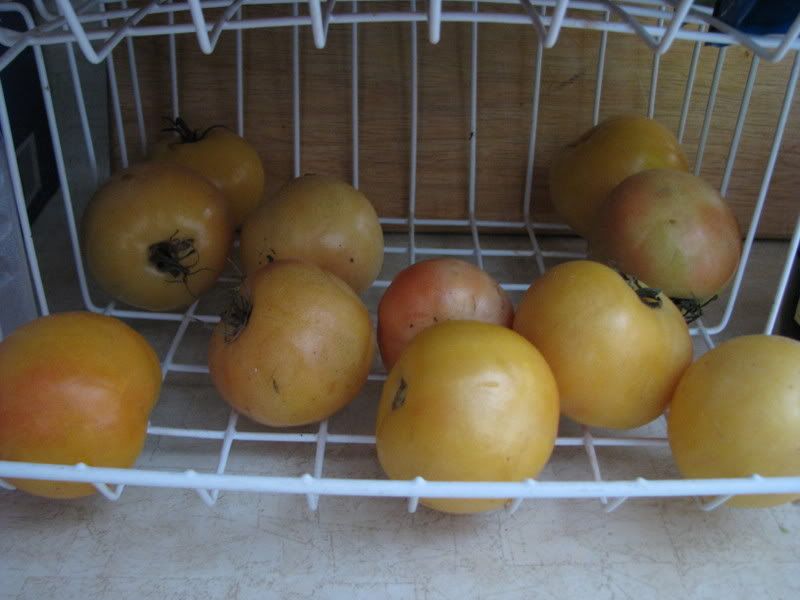
Winter Keeper tomatoes nearly all eaten up.
These are long storage tomatoes by the name of Winter Keeper, a variety that I got from Mapple Farms. They have been sitting on this rack since the end of September and have been slowly ripening ever after. Some but only a few have succumbed to rot. Most have stayed blushy gold with a red interior until I eat them. The taste is no where near as sublime as a sun ripened tomato but it is not bad considering they have been riding the shelf for the past 4 months.
Let us harken backward to other end too where I am starting Tiny Tim dwarf tomato because I'm curious how well it will grow on a window sill. I'm also going to be trying Red Robin which is apparently adapted to this sort of growing. Aren't they cute?
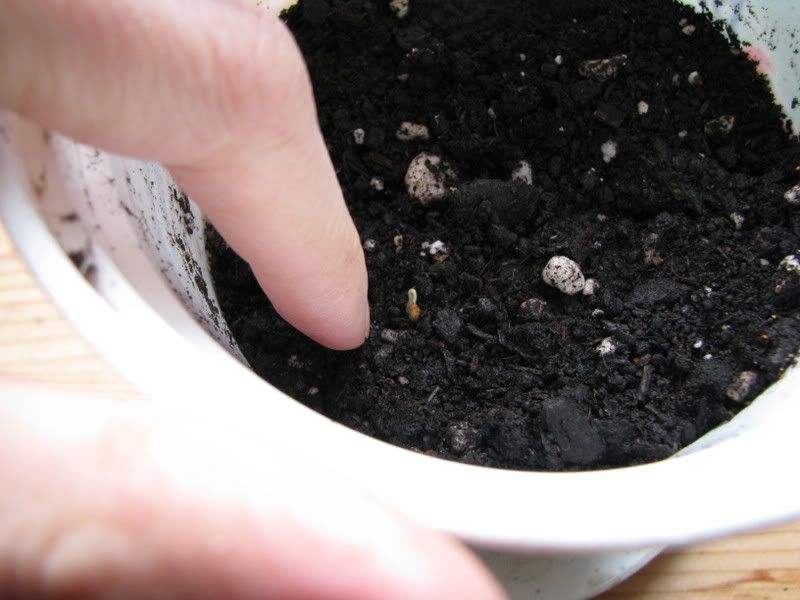
Teeny tiny baby tomato with huge pointing finger.

Winter Keeper tomatoes nearly all eaten up.
These are long storage tomatoes by the name of Winter Keeper, a variety that I got from Mapple Farms. They have been sitting on this rack since the end of September and have been slowly ripening ever after. Some but only a few have succumbed to rot. Most have stayed blushy gold with a red interior until I eat them. The taste is no where near as sublime as a sun ripened tomato but it is not bad considering they have been riding the shelf for the past 4 months.
Let us harken backward to other end too where I am starting Tiny Tim dwarf tomato because I'm curious how well it will grow on a window sill. I'm also going to be trying Red Robin which is apparently adapted to this sort of growing. Aren't they cute?

Teeny tiny baby tomato with huge pointing finger.
Thursday, January 15, 2009
What should I grow? A primer of classic vegetables
If you are a fellow urban 'farmer,' then this time of year is filled with intricate 4 dimensional planting charts, and painful decisions about what not to plant. Then again, perhaps you just embrace the seeds but then wonder when the time comes where you are going to cram all those plants? Or maybe you are new to vegetable gardening and are trying to decide what best to plant? Well, friends, I am here to try to help because it is my trial too so let us think of some criteria:
a. Will my family eat it?
b. Will it grow with minimum fuss here?
c. Is it a space hog or will it provide me with maximum food output with minimum space?
d. Does it taste better fresh fresh, not normally available or is very expensive?
e. Is the store bought / non organic version normally high in pesticides?
Don't feel like playing my Q&A game then let me give you some common, mostly annual veggies that meet many of the above criteria.
1. Beans: easy to grow, you can plant 2-4 inches apart. Fresh beans are available abundantly during the summer and pole beans can be trellised. Also, it's one of the easiest plants from which to save seed.

Sideways picture 'Hunter' bean with broad pods and a ladybug.
2. Peas: See above and add that freshly shelled peas are an exquisite taste that you have to experience to believe. I experience it seldomly as my kids eat most of them.

Glowing peas
3. Roots: carrots, turnips and beets. They don't take up much space and their growing requirements are meagre - a bit of sun, a bit (not too much) fertility and adequate watering. Carrot*, turnip and beet tops are also edible so eat your thinnings. You can often get two crops in a year too. Carrots are one of the dirty dozen food that has a high pesticide residue to boot.

Turnip 'orange jelly' I think it's called and a golden beet by the looks of it beside dandelion?
4.Greens: lettuce, kale, spinach and the like are easy to grow tucked in between plants as they appreciate a little coolness in the summer months. They are not high in calories but superstars when it comes to providing you green vitamen vitality! Also on the dirty dozen list.
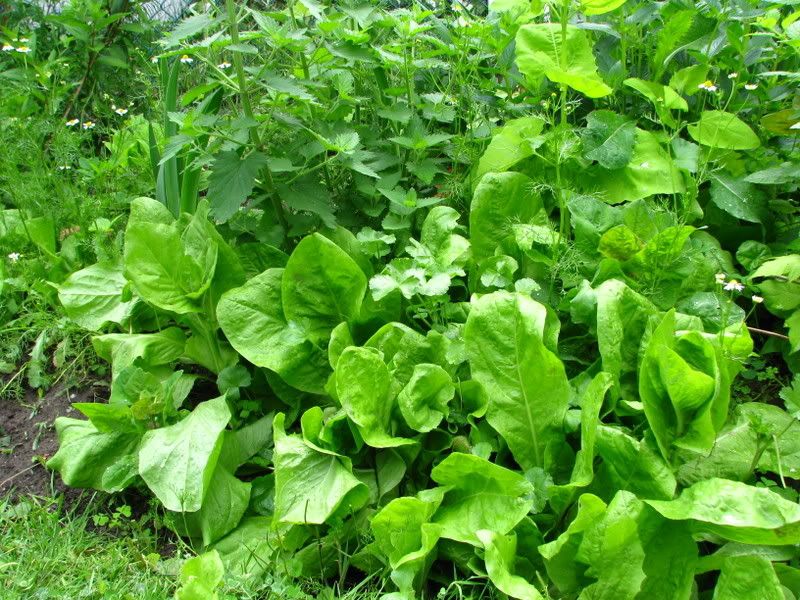
Self sown sugarloaf chicory
5. Peppers, especially bell peppers, tomatoes and potatoes are all sprayed within an inch of their life. Thankfully they'll all grow in containers. Just choose shorter varieties unless you have really big containers as indeterminate tomatoes are impressively large by the end of the season and bit tops usually mean big bottoms, ie the roots. If you have the space, potatoes are quite fun to grow. Kids enjoy helping plant the tubers and then dig up the treasures at harvest. Growing your own will also allow you to experience a diversity of varieties that is just not available at the grocery store.
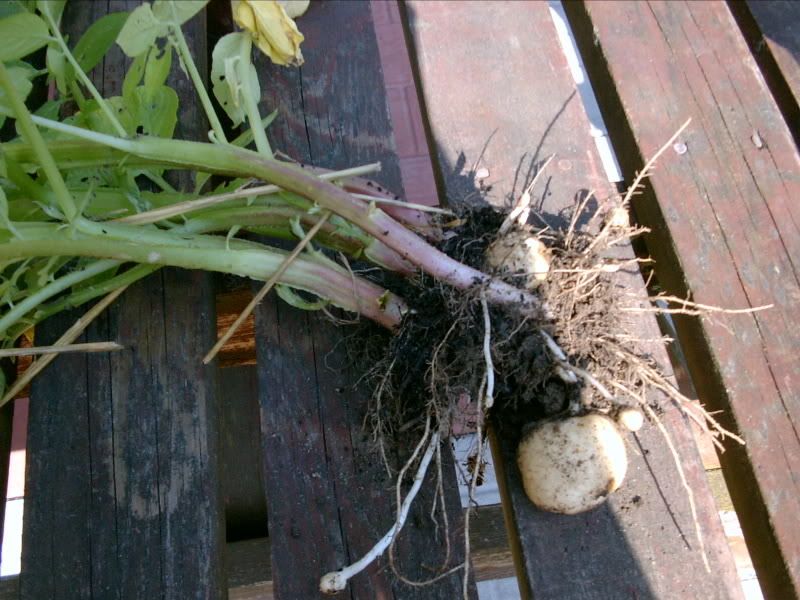
Baby potatoes, the early crop.
Have a bit more space, then consider:
6. Strawberries and other soft fruit like grapes whose thin skins easily absorb pesticide residues.
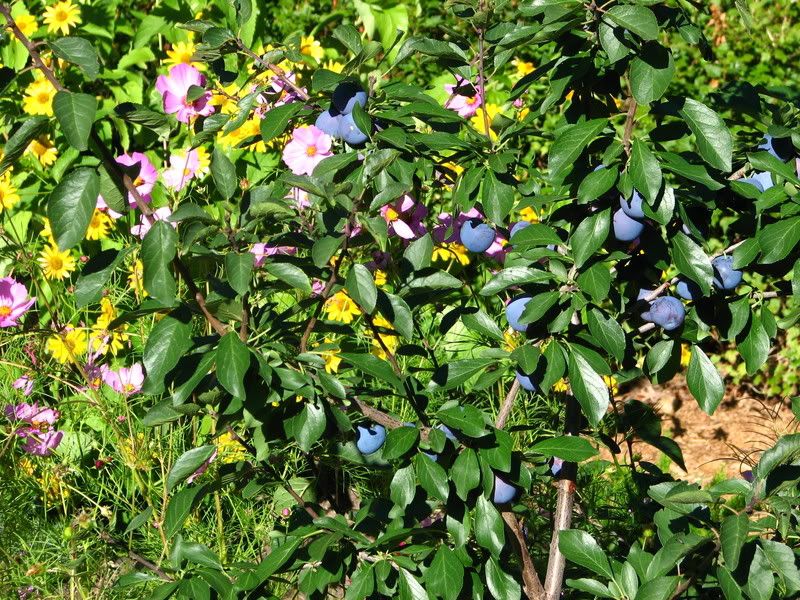
Plums and cosmos happy together.
7. Cucumbers and squash whose rampant vines can be trellised for cleaner harvest, better air circulation that cuts down on diseases, and of course to save on room. Many kinds grow well in containers too.
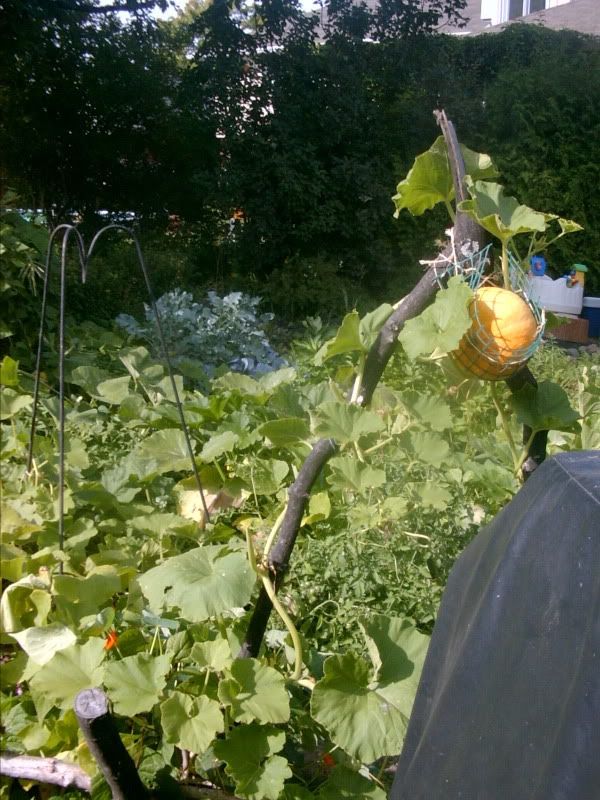
Pontimarron squash I believe.
Even more space? Here are some high calorie crops to add to the mix:
8. Onions and leeks are both recommended by Jeavons, author of 'How to grow more vegetables,' the biointensive method.

Yummy onions... pictures of leeks lacking due to leek moth. I hope they enjoyed them.
9. Other roots like parsnip and sweet potato. Short season sweet potatoes will grow very well here with clear plastic mulched beds. Some have success in containers too.
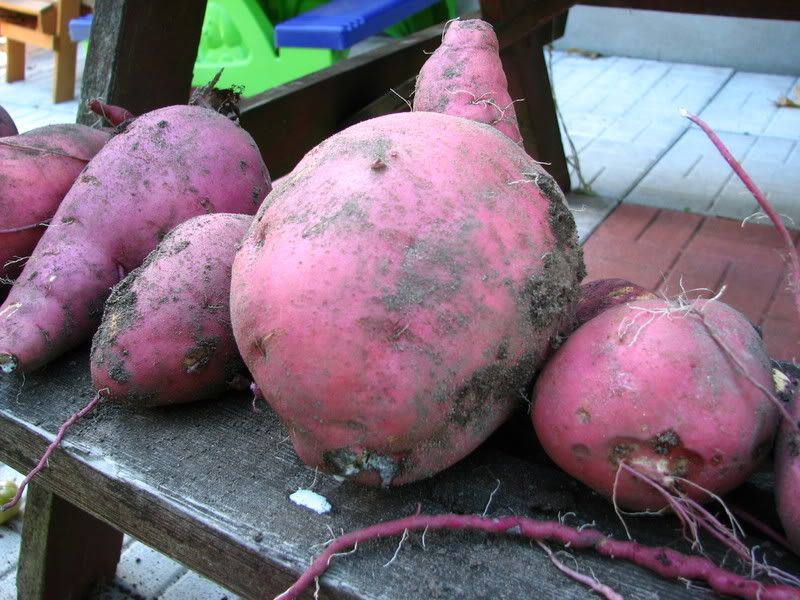
Super delicious sweety 'Georgia Jet'
10. Grains and more pulses like lentils, chickpeas and dried beans. Combined with wheat, hulless barley, amaranth, and corn, you will get a very healthful meal.

Various dried legumes: peas, chickpeas, and beans
And my recommendation.
11. Cabbage fun to grow and surprisingly delicious fresh. It also keeps well in the winter in the back of my fridge. I've put it last as it is a space hog though I commonly space cabbage and broccoli only 12 inches apart and they grow smaller but sizeable heads in fertile soil.
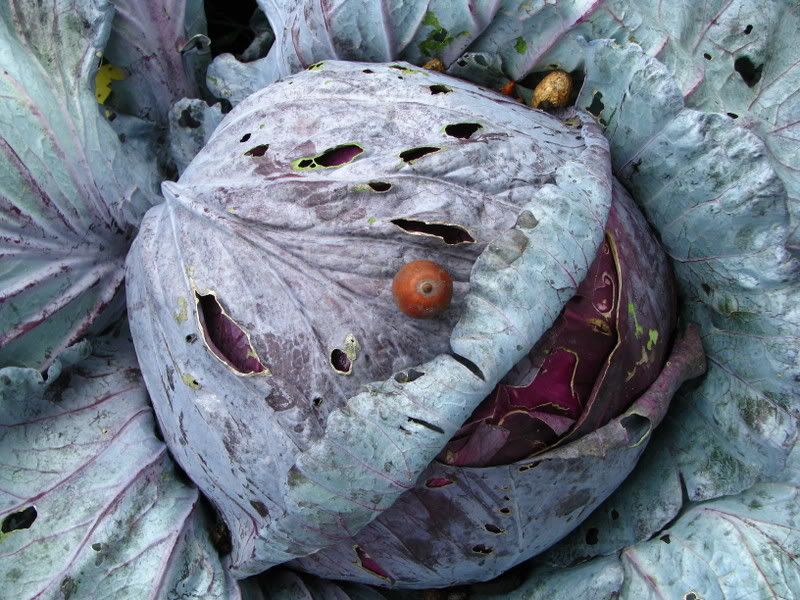
Yes, I really love this picture. (It's been posted before...)
12. Lots of other veggies of course.
Enjoy and remember, Seedy Saturday with its seed trading table is coming up soon.
a. Will my family eat it?
b. Will it grow with minimum fuss here?
c. Is it a space hog or will it provide me with maximum food output with minimum space?
d. Does it taste better fresh fresh, not normally available or is very expensive?
e. Is the store bought / non organic version normally high in pesticides?
Don't feel like playing my Q&A game then let me give you some common, mostly annual veggies that meet many of the above criteria.
1. Beans: easy to grow, you can plant 2-4 inches apart. Fresh beans are available abundantly during the summer and pole beans can be trellised. Also, it's one of the easiest plants from which to save seed.

Sideways picture 'Hunter' bean with broad pods and a ladybug.
2. Peas: See above and add that freshly shelled peas are an exquisite taste that you have to experience to believe. I experience it seldomly as my kids eat most of them.

Glowing peas
3. Roots: carrots, turnips and beets. They don't take up much space and their growing requirements are meagre - a bit of sun, a bit (not too much) fertility and adequate watering. Carrot*, turnip and beet tops are also edible so eat your thinnings. You can often get two crops in a year too. Carrots are one of the dirty dozen food that has a high pesticide residue to boot.

Turnip 'orange jelly' I think it's called and a golden beet by the looks of it beside dandelion?
4.Greens: lettuce, kale, spinach and the like are easy to grow tucked in between plants as they appreciate a little coolness in the summer months. They are not high in calories but superstars when it comes to providing you green vitamen vitality! Also on the dirty dozen list.

Self sown sugarloaf chicory
5. Peppers, especially bell peppers, tomatoes and potatoes are all sprayed within an inch of their life. Thankfully they'll all grow in containers. Just choose shorter varieties unless you have really big containers as indeterminate tomatoes are impressively large by the end of the season and bit tops usually mean big bottoms, ie the roots. If you have the space, potatoes are quite fun to grow. Kids enjoy helping plant the tubers and then dig up the treasures at harvest. Growing your own will also allow you to experience a diversity of varieties that is just not available at the grocery store.

Baby potatoes, the early crop.
Have a bit more space, then consider:
6. Strawberries and other soft fruit like grapes whose thin skins easily absorb pesticide residues.

Plums and cosmos happy together.
7. Cucumbers and squash whose rampant vines can be trellised for cleaner harvest, better air circulation that cuts down on diseases, and of course to save on room. Many kinds grow well in containers too.

Pontimarron squash I believe.
Even more space? Here are some high calorie crops to add to the mix:
8. Onions and leeks are both recommended by Jeavons, author of 'How to grow more vegetables,' the biointensive method.

Yummy onions... pictures of leeks lacking due to leek moth. I hope they enjoyed them.
9. Other roots like parsnip and sweet potato. Short season sweet potatoes will grow very well here with clear plastic mulched beds. Some have success in containers too.

Super delicious sweety 'Georgia Jet'
10. Grains and more pulses like lentils, chickpeas and dried beans. Combined with wheat, hulless barley, amaranth, and corn, you will get a very healthful meal.

Various dried legumes: peas, chickpeas, and beans
And my recommendation.
11. Cabbage fun to grow and surprisingly delicious fresh. It also keeps well in the winter in the back of my fridge. I've put it last as it is a space hog though I commonly space cabbage and broccoli only 12 inches apart and they grow smaller but sizeable heads in fertile soil.

Yes, I really love this picture. (It's been posted before...)
12. Lots of other veggies of course.
Enjoy and remember, Seedy Saturday with its seed trading table is coming up soon.
Labels:
brassica,
gardening 201,
greens,
roots,
seedy saturday,
solanums
Monday, January 12, 2009
Tomato seed fun
So you know when you get a pack of tomato seeds and you think: "Great, I really wanted to try an OP variety of Sungold or that weird varigated tomato that everyone says tastes so-so but it sure looks cool, but I don't want 15-30 plants!"
Well folks, I propose that we start swapping tomato seeds. If you are interested, I will send you three seeds of your chosen variety while supplies last and once they arrive. In return, I am looking for early to mid season tomatoes of varying kinds with a special interest this year in long storage types, drying types, hanging to store types weird types like 'stick / curl' and indoor dwarfs. This year you can choose from:
Black cherry
Purple plum
Tiny Tim
Sub-arctic
Variegated
Velvet Red
Red Robin
Principe Borghese
Grappoli d'Inverno
Chiapas wild
Red cluster pear (multiflora)
Make me an offer I can't refuse (3 seeds).
Well folks, I propose that we start swapping tomato seeds. If you are interested, I will send you three seeds of your chosen variety while supplies last and once they arrive. In return, I am looking for early to mid season tomatoes of varying kinds with a special interest this year in long storage types, drying types, hanging to store types weird types like 'stick / curl' and indoor dwarfs. This year you can choose from:
Black cherry
Purple plum
Tiny Tim
Sub-arctic
Variegated
Velvet Red
Red Robin
Principe Borghese
Grappoli d'Inverno
Chiapas wild
Red cluster pear (multiflora)
Make me an offer I can't refuse (3 seeds).
Harvest Day - it's too darn cold!
I was going to go out and show you my coldframes today:
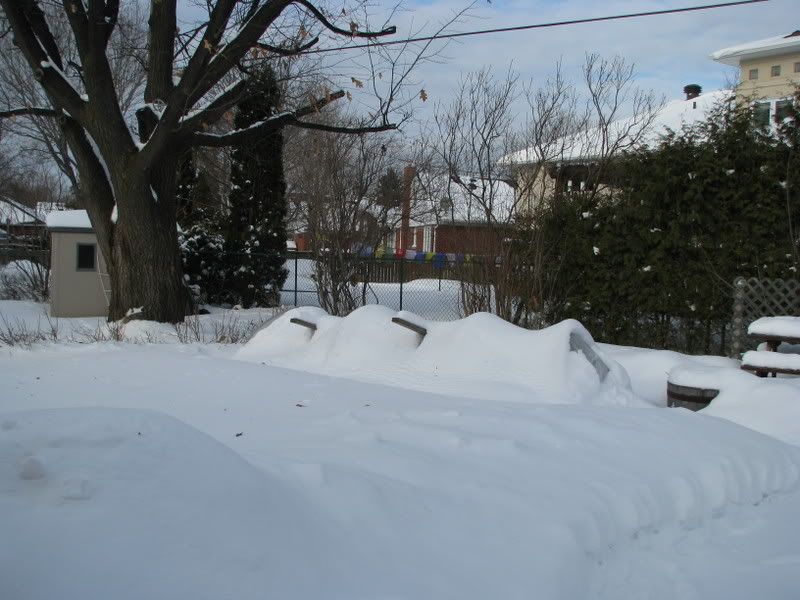
But I figured with the -20 temps that we were going to get shortly that I shouldn't take the insulating blanket off my babies until next week when temps are going to moderate again.
Snow as an Insulator
A gardener friend once told me that the average temperature under a good snow cover was about -5 Degrees Celcius. This intrigued me so I thought we should put it to the test and find out what the experts said. Apparently inside a well built igloo, the temperature is around 2C. Snow can help protect plants from the freezing and drying winds of winter and moderate temperatures so that the plants don't go through repeated freeze thaw cycles. I'm not the only one who says so - there are other bloggers like in This Garden Is Illegal.
Anyhow, don't curse the white stuff except when you're shovelling and then make mazes in your driveway and say your doing it for your kids, dogs or very hardy cats...
OK, I'm bored of this topic now.

But I figured with the -20 temps that we were going to get shortly that I shouldn't take the insulating blanket off my babies until next week when temps are going to moderate again.
Snow as an Insulator
A gardener friend once told me that the average temperature under a good snow cover was about -5 Degrees Celcius. This intrigued me so I thought we should put it to the test and find out what the experts said. Apparently inside a well built igloo, the temperature is around 2C. Snow can help protect plants from the freezing and drying winds of winter and moderate temperatures so that the plants don't go through repeated freeze thaw cycles. I'm not the only one who says so - there are other bloggers like in This Garden Is Illegal.
Anyhow, don't curse the white stuff except when you're shovelling and then make mazes in your driveway and say your doing it for your kids, dogs or very hardy cats...
OK, I'm bored of this topic now.
Monday, January 5, 2009
Time to start sowing seeds - wintersown
Sunny Snow Sprinkles
Feel free to suggest a better name but check it out, if you look close you will see that it is snowing and sunny at the same time.
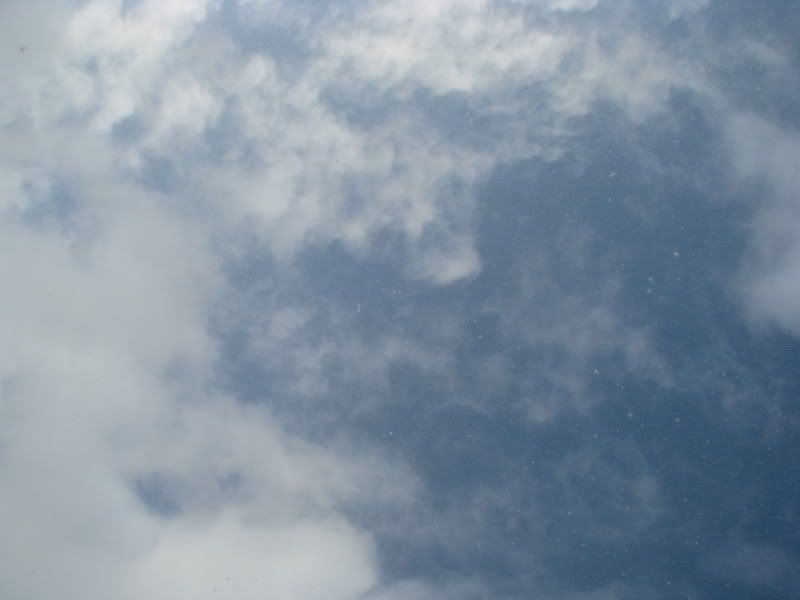
Wintersown
I ran into this idea a few years back. A creative gardener decided to try her hand at sowing seeds outdoors in the middle of winter in mini-greenhouses using recycled material. Not only is this the ideal method for anything that requires some sort of stratification or that naturally sows itself in your area, it is used on tomatoes (etc) too! I have never tried the latter so I'll give it a whirl this year.
I highly recommend you check out this innovative and creative technique:
http://www.wintersown.org/wseo1/index.html
My old blog's adventures in making the pop bottle type.
***
Hey I logged on for Harvest Monday? Well today I am harvesting from my root cellar, freezer, and indoor counter tops. I'll brave the coldframe next week.
Feel free to suggest a better name but check it out, if you look close you will see that it is snowing and sunny at the same time.

Wintersown
I ran into this idea a few years back. A creative gardener decided to try her hand at sowing seeds outdoors in the middle of winter in mini-greenhouses using recycled material. Not only is this the ideal method for anything that requires some sort of stratification or that naturally sows itself in your area, it is used on tomatoes (etc) too! I have never tried the latter so I'll give it a whirl this year.
I highly recommend you check out this innovative and creative technique:
http://www.wintersown.org/wseo1/index.html
My old blog's adventures in making the pop bottle type.
***
Hey I logged on for Harvest Monday? Well today I am harvesting from my root cellar, freezer, and indoor counter tops. I'll brave the coldframe next week.
Saturday, January 3, 2009
Overwintering hot peppers - so far so good
I thought instead of rattling on about the latest garden subject I was heavily googling (right now I'm looking decorative and tasty members of the rumex and chenopodium genus - look up Rhubarb Pie or Saucy Sorrel, darn pretty), I thought I'd let you know how my garden was doing.
Mostly, it's buried in snow. The two pepper plants that I am overwintering are doing well with descent leaf coverage as you can see on this 3 year old Fatali despite the low light levels. Now that we've passed through winter solastice, they should start to leaf out even more.
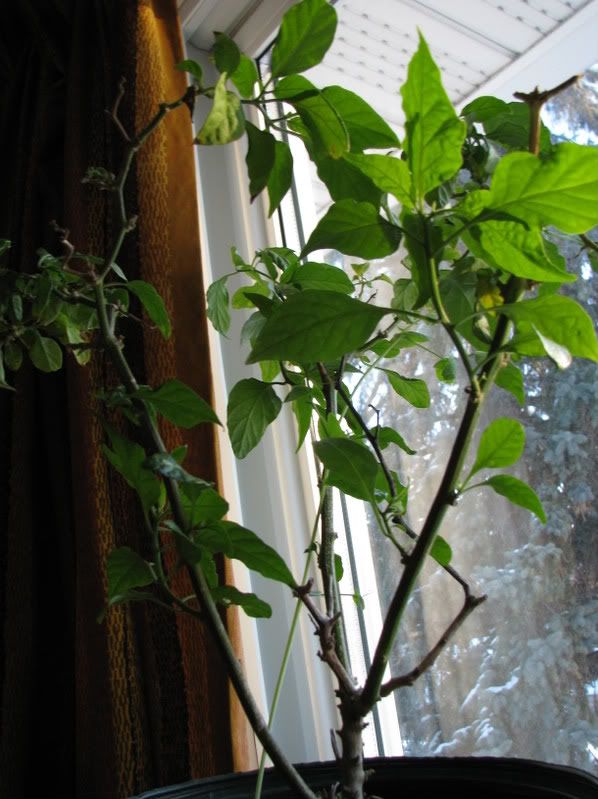
3 year old Fatali Habanero
I've even got ripening fruit on my 3 year old Long Cayenne.
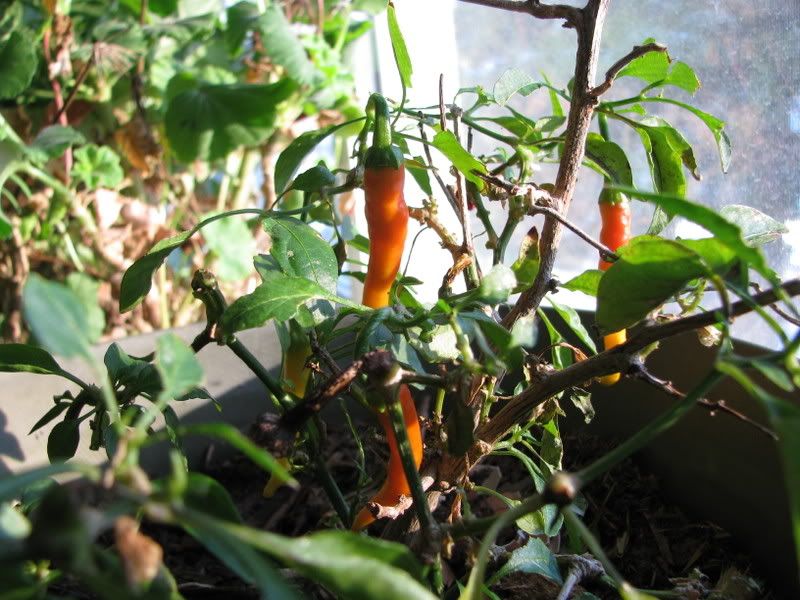
3 year old Long Red Cayenne
It's the time of year that I normally repot these plants.
Overwintering peppers from this blog
Overwintering peppers from my old blog Ottawa Hortiphilia.
Some other guy at Hot Pepper Seeds gives you the dirt on overwintering peppers.
Mostly, it's buried in snow. The two pepper plants that I am overwintering are doing well with descent leaf coverage as you can see on this 3 year old Fatali despite the low light levels. Now that we've passed through winter solastice, they should start to leaf out even more.

3 year old Fatali Habanero
I've even got ripening fruit on my 3 year old Long Cayenne.

3 year old Long Red Cayenne
It's the time of year that I normally repot these plants.
Overwintering peppers from this blog
Overwintering peppers from my old blog Ottawa Hortiphilia.
Some other guy at Hot Pepper Seeds gives you the dirt on overwintering peppers.
Subscribe to:
Posts (Atom)
